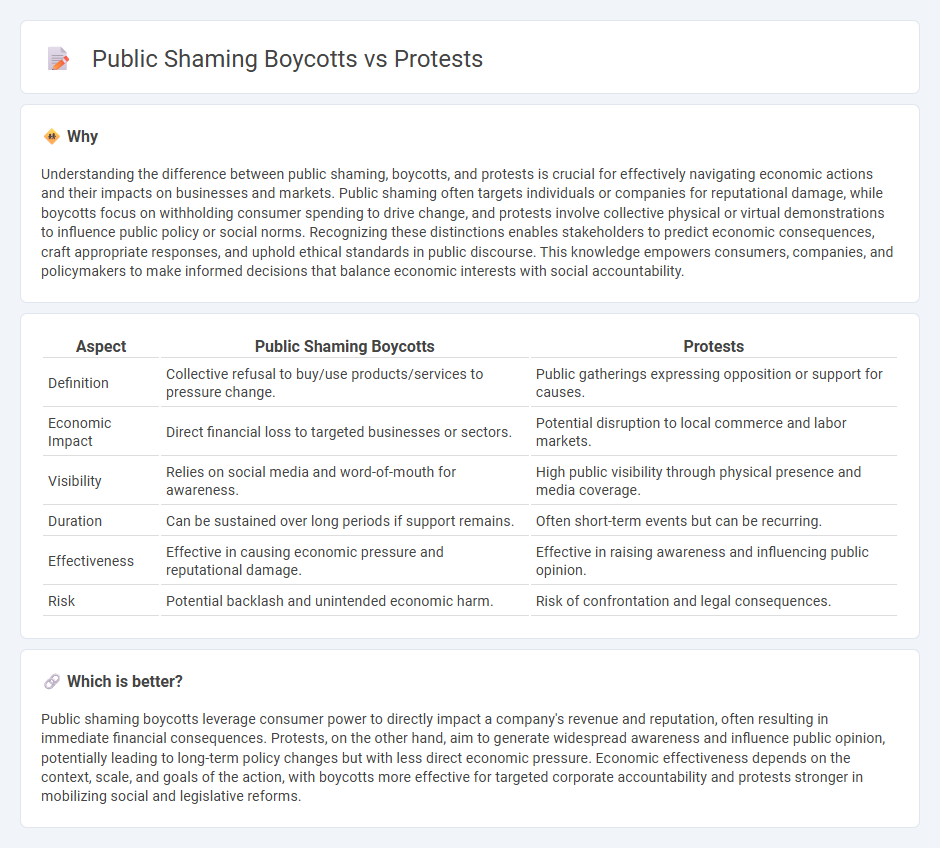
Public shaming boycotts and traditional protests each play distinct roles in shaping economic outcomes and influencing corporate behavior. Boycotts directly impact a company's revenue by targeting consumer spending, while protests primarily raise awareness and apply social pressure without immediate financial consequences. Explore how these strategies differ in effectiveness and influence on market dynamics.
Why it is important
Understanding the difference between public shaming, boycotts, and protests is crucial for effectively navigating economic actions and their impacts on businesses and markets. Public shaming often targets individuals or companies for reputational damage, while boycotts focus on withholding consumer spending to drive change, and protests involve collective physical or virtual demonstrations to influence public policy or social norms. Recognizing these distinctions enables stakeholders to predict economic consequences, craft appropriate responses, and uphold ethical standards in public discourse. This knowledge empowers consumers, companies, and policymakers to make informed decisions that balance economic interests with social accountability.
Comparison Table
| Aspect | Public Shaming Boycotts | Protests |
|---|---|---|
| Definition | Collective refusal to buy/use products/services to pressure change. | Public gatherings expressing opposition or support for causes. |
| Economic Impact | Direct financial loss to targeted businesses or sectors. | Potential disruption to local commerce and labor markets. |
| Visibility | Relies on social media and word-of-mouth for awareness. | High public visibility through physical presence and media coverage. |
| Duration | Can be sustained over long periods if support remains. | Often short-term events but can be recurring. |
| Effectiveness | Effective in causing economic pressure and reputational damage. | Effective in raising awareness and influencing public opinion. |
| Risk | Potential backlash and unintended economic harm. | Risk of confrontation and legal consequences. |
Which is better?
Public shaming boycotts leverage consumer power to directly impact a company's revenue and reputation, often resulting in immediate financial consequences. Protests, on the other hand, aim to generate widespread awareness and influence public opinion, potentially leading to long-term policy changes but with less direct economic pressure. Economic effectiveness depends on the context, scale, and goals of the action, with boycotts more effective for targeted corporate accountability and protests stronger in mobilizing social and legislative reforms.
Connection
Public shaming, boycotts, and protests directly impact the economy by influencing consumer behavior and corporate reputations, often leading to shifts in market demand and sales revenue. These collective actions can pressure businesses to change practices, affect stock prices, and alter investment flows. The economic repercussions of such social movements demonstrate the power of public sentiment in driving corporate and policy decisions.
Key Terms
Consumer Activism
Consumer activism harnesses protests, public shaming, and boycotts as powerful tools to influence corporate behavior and promote ethical practices. Protests raise collective awareness through visible demonstrations, while public shaming leverages social media to pressure companies by exposing misconduct, and boycotts directly impact revenue by encouraging consumers to avoid harmful products. Explore the dynamics and effectiveness of these strategies to better understand how consumer activism drives social change.
Market Power
Protests leverage collective action to raise awareness and pressure entities by demonstrating widespread dissatisfaction, while public shaming boycotts target market power by directly impacting a company's revenue through organized consumer withdrawal. The effectiveness of boycotts hinges on the scale of participation and the company's reliance on consumer patronage, making market power a critical factor in determining outcomes. Explore how strategic mobilization influences market dynamics and corporate behavior.
Reputational Risk
Protests and public shaming boycotts both present significant reputational risks to organizations by drawing widespread public attention and scrutiny. Protests often generate immediate, visible pressure, impacting brand perception and stakeholder trust, whereas boycotts can lead to long-term financial losses and sustained reputational damage through consumer avoidance. Explore more on how these tactics influence corporate reputation and risk management strategies.
Source and External Links
Protect the Protest - People have a fundamental right to protest peacefully, and it is the state's duty to respect and protect this right, with protests playing a crucial role in driving social and political change throughout history.
Protest - Wikipedia - Protests are public acts of objection or dissent that take many forms such as marches, civil disobedience, and picketing, and while they are mostly peaceful, some can involve collective violence from a small minority of participants.
Protesters' Rights - ACLU - The First Amendment protects the right to assemble and express views through protests, although police can place certain restrictions that are necessary and proportionate to maintain safety and public order.
 dowidth.com
dowidth.com